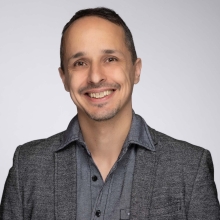Profile
Simon Gravel
Simon Gravel obtained his BSc and MSc in Mathematics and Physics from the Université de Montréal and his PhD in Physics from Cornell University in 2009. His research in Genetics began during a short postdoc in the Physics department at the Universität zu Köln and the Kavli Institute for Theoretical Physics in Santa Barbara, and continued in the Genetics department at Stanford University. He joined the Department of Human Genetics as an Assistant Professor at McGill and the Genome Quebec Innovation Centre in 2013.
Professor Gravel’s is interested in learning about biology and evolution through creative analysis of high-throughput biological data. His group develops mathematical and statistical methods that take advantage of diverse data sources to refine our understanding of fundamental parameters of human history and biology. His recent research has focused on how the history of diverse human populations affected patterns of genetic diversity and disease. His group made contributions about the origins of modern humans, the successive waves of migrations that led to the formations of contemporary populations in the Americas, as well as the identification of genetic predispositions for disease.
This research is largely data-driven, and it combines modeling at multiple levels: we first wish to understand the fundamental biology underpinning evolution, such as the processes of mutation, recombination, and selection. To understand human genomes, we also need to understand how recent and ancient human history affected patterns of genetic diversity: ancient population expansions, recent migrations, and marriage patterns all impact genomic diversity, and in many cases we can reconstruct these events through careful modelling. Finally, we need to understand the behavior of cutting edge technology involved in the latest datasets. Professor Gravel’s group has projects focusing on anthropology and history, technology development, biology, and medicine, and is always happy to explore new opportunities involving new technologies and creative mathematical modeling.

